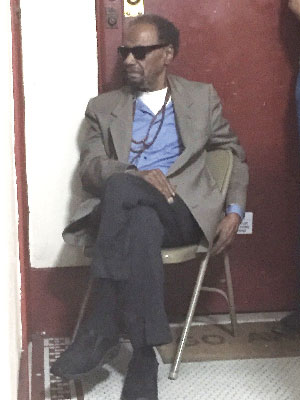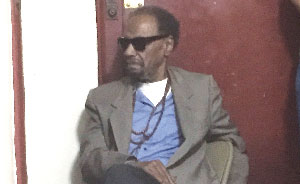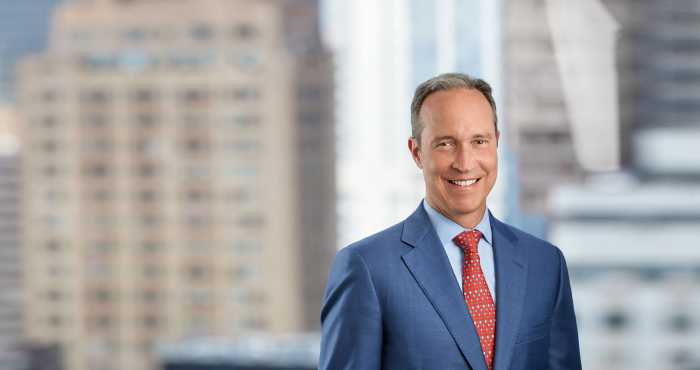
Steve Cannon at Marjorie Eliot’s Parlor Jazz Series in Harlem.
BY BOB HOLMAN | After being evicted from A Gathering of the Tribes, his gallery/performance space/crash pad, 18 months ago Steve Cannon, the Blind Professor of Loisaida (that’s Nuyorican for the Lower East Side), has settled in as scholar, documentarian and éminence grise. But now he’s got a new cause and his activist roots are showing.
“A statue or memorial for Allen Ginsberg in Tompkins Square Park! It’s got to happen!” he’s shouting into the phone and into the ears of the two assistants, one city nurse and the usual crew of poets and artists arrayed in his living room at 745 E. Sixth, Apt. 1A, right at the corner of Avenue D.
The man who The New York Times saw as the gateway to alternate culture now wants to ensure that the icons of his neighborhood do not disappear into the current gentrifying Fog of Forgetfulness.
The lecture continues — “Look at Ukraine! The George Washington of Ukraine was a poet, and they got statues of Shevchenko everywhere! They even got his bust up over there on Second Avenue, by Veselka! Derek Walcott’s statue in St. Lucia. Ralph Ellison’s ‘Invisible Man’ is up in Harlem. Bob, you told me about the Mahmoud Darwish Park in Ramallah — you can have poetry readings there! We need a statue of Allen to keep poetry in Tompkins Square Park!”
I drop by Steve’s place with Adam Falkner, the brand-new director of Urban Word, the after-school writing program that sponsors the city’s youth poet laureate and has young poets reading during halftime at Knicks games. (Used to be a young poet was someone who qualified for the Yale Younger Poets Prize — under 40. Now, it’s a 12-year old.)
Adam’s never had the chance to meet this living legend before, and he’s loving Steve’s instant karma critiques. Who wouldn’t? Already Adam is talking about getting some Urban Word youths to read to Steve.
“It’s amazing how you guys move from scene to scene, from Lincoln Center to a Downtown bar,” Adam says, “from Tribes to PEN to the American Academy.”
“That’s nothin’, that’s a book,” Steve says. Adam gets it.
He also gets that Steve has been lending a hand to young artists for decades — that generations of Lower East Side poets have been mentored by this man — Paul Beatty, Tracie Morris, Reg E Gaines, Saul Williams, Sara Jones. If artists had stars in the sidewalk here, they’d lead to Steve’s front door, to A Gathering of the Tribes, with its renowned David Hammons living room.
Would that the city had got Steve Cannon a little bit more before he was evicted last spring from the gallery/performance space he ran for 25 years on Third and C. Tribes was a one-stop culture chop shop — fresh art on the walls, a constant stream of visitors, live music and poetry performances, a publisher of a great magazine and a series of poetry books. Oh, did I mention that Steve Cannon is blind (“The only admittedly blind gallery owner in New York City”), black and 80 years old?
On our way Uptown to hear the jazz concert in Harlem, Steve is a nonstop rant. Ishmael Reed — an old friend of Steve’s, they founded a small press together, Reed Cannon Books — is in town.
“I know he’s going to show up and bang on the damn piano and go on complaining about ‘Hamilton,’ ” Steve predicts. Then he starts in on another old pal, David Henderson, who is moaning about the Dark Room Collective, how they’re erasing Umbra, referring to the collective of black artists who stayed avant-garde and Downtown while LeRoi Jones moved Uptown, became Amiri Baraka and started the Black Arts Movement.
“And we need a statue of Baraka, too!” Cannon preaches on, “over in Newark.”
But with Baraka’s son, Ras, as mayor, wouldn’t that smell a bit of nepotism?
“Hell no, Bob! It’s a gift to the community! Ras is doing a great job — surely, you read that piece on the front page of the Times?”
I inform Steve of the new Baraka tribute album that poet Thomas Sayers Ellis of Dark Room Collective has released, terrific contemporary jazz renditions of Baraka poetry, “Heroes Are Gang Leaders/The Amiri Baraka Sessions.”
“Get Ellis to resurrect Umbra!” says Steve.
And speaking of jazz, he sharpens his intentions to a whisper, “Bird’s got to be down here, too. You know he died here. Gotta have a statue of Bird!”
Charlie Parker is another of Steve’s icons to be memorialized. Steve helped start the Charlie Parker Jazz Festival, and for years there was a huge poetry celebration in the Tribes backyard as part of the Lower East Side’s annual Charlie Parker Jazz Festival.
“Tribes did it, we’re in the history books,” Steve reflects. “I am content. I’ve got it figured out so that the books should all come out by June of next year. And then I know what my job is. After 25 years it’s second nature, I can do it with my eyes closed. Don’t forget, Bob, that I started Tribes the year after I retired from being a professor,” he says, pointing directly to his Medgar Evers (CUNY) College Professor Emeritus diploma on the wall.
“Yes, Gil Scott Heron was my student,” Steve notes. “But when I felt that energy around the Nuyorican when it reopened a block away — location, location, location!
“Then there was the time that Zoe burned down my house, but that’s another story.
“The deal is gentrification. Speaking in generalities, here, but Vipin took me for a walk the other day, and Avenue B was filled with drunks. Drunks at brunch — what could be worse? They weren’t talking about poetry and music, it was sad. They were talking about bulls— gossip, uninventive and borrrring. I’ve seen the neighborhood change, and change again, and change after that. But it was wave after wave of artists that came into Tribes. Leaving that place, well, I just left the hassles. Artists were being more demanding, and not giving back like they used to.
“O.K., I’ll say it,” he continues. “It’s a change for the worse. I mean I still hear the young artists — ‘I just got out of school, I want to be a poet, where do I go?’ And what’s happened here on the Lower East Side — look at Williamsburg, it happened there, and Bushwick I hear is now just as bad. You know and I know that artists will always find a way. But for Tribes, that job is done. What we did for black poets and Puerto Ricans, Dominicans, Asians, Indians, I sure do miss Diane Burns, that’s part of it. That’s why Tribes got started, let’s be upfront about that. But it’s never been about the blacks, whites, anybody. It’s been about everybody. That’s it. What do you hear about in New Orleans, my hometown? It’s the same thing — gentrification there. The Times had that poll, did you see it? Seventy percent of white folks thought New Orleans was back after Katrina, and 70 percent of black folks said it wasn’t. The population has shifted.
“My advice for young artists is the same as always, it’s D.I.Y., Do It Yourself,” Steve offers. “Publish it yourself. Put your art up on the sidewalks in Tompkins Square Park, use the subway. Let the city be your gallery, your book, your stage. You got some friends around you? Throw a reading, throw a party, just do it. Gather your own tribe. If you’ve got the numbers, go ahead, start an organization. Get a place and show your films. If it’s large enough, invite the dancers in.
“When I stopped teaching, I dedicated myself to the community to encourage the young people. Encourage — that’s it. Someone says no to you, don’t accept it. Prove ’em wrong. I want people to know that I’m still here: 212-777-2038 or just drop by 745 E. Sixth, push the buzzer 1A, and come in and introduce yourself. Be part of the new Gathering of the Tribes. E-mail? Sure. gatheringofthetribes@gmail.com. Tell them the Blind Guy sent you.”




































